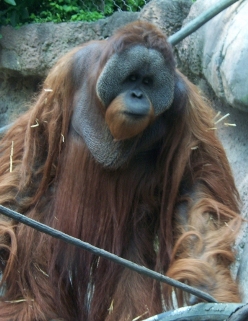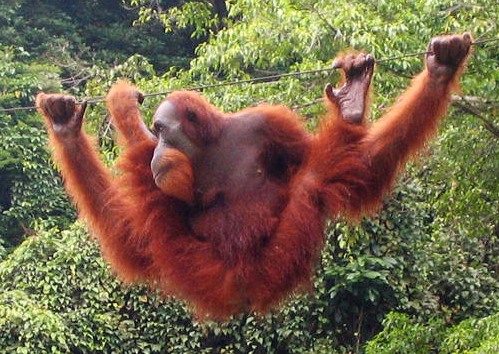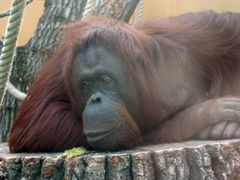Orangutan Species
Until recently, Orangutans have traditionally been classified only as the Bornean Orangutan, Pongo pygmaeus. The Sumatran Orangutan, Pongo albelii, was considered a sub-family of the species. Now Pongo albelii and Pongo pygmaeus are classified into separate species under the genus Pongo. The island separation of Borneo and Sumatra led to the differences in the these two Orangutan species.
Bornean Orangutan - (Pongo pygmaeus)
| The Bornean
Orangutan has a darker, almost chocolate hair covering their bodies.
The adult males of Borneo have more robust bodies than P. albelii
and their cheek pads are larger and shaped differently. In Borneo
it has been observed that the rainforests support less than 1 to 3
Orangutans per square kilometer (5). The island of Borneo is the third largest island in the world and it is divided by high mountain ranges. These ranges are impassable in most parts as the straits that separate the islands of Sumatra and Borneo. This has led to biologists recognizing three major regions of Borneo that have possibly produced three sub-species of Pongo pygmaeus. In the east of the island Orangutans have a chocolate colored coat compared to the southwest where the coats are a red-orange color. This region of the island is closest to Sumatra, which may explain why the color of these Orangutans is so closely related. |
 |
Sumatran Orangutan - (Pongo albelii)
| The Sumatran Orangutan has a red-orange coat of hair that is white around the mouth and abdomen. The males of this species have a better throat beard than do the males of the Borneo. Orangutans are a solitary animal, but Pongo albelii tends to be the more social Orangutan of the two species. The richer forests in Sumatra can support no more than 6 to 7 Orangutans per square kilometer (5). |
 |
